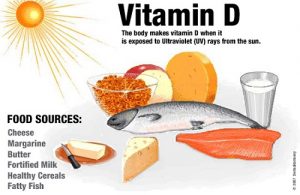Spring has most certainly sprung and lately it seems as if we’re heading for an excellent summer – fingers crossed! As the days grow warmer you might be thinking about a trip to the beach, the local pool, or getting ready for some summer sports. Perhaps you just like being outdoors getting more exercise, doing garden work and enjoying the warmer weather. Whatever you plans its important to be “sun smart” – the sun can be a force for health, but in some cases can make you ill – so what’s best when it comes to the sunshine?!
Isn’t direct sunlight bad for you?
We’ve all been taught that we need to cover up when we go out in the sun, either with clothes or sunscreen – while you should always play it safe (especially with children) it’s also worth considering the benefits of moderate sun exposure. It’s sunshine which allows out body to produce vitamin D, a critical element in maintaining a healthy immune system.
Research suggests that a small dose of direct sun (between five and 30 minutes, depending on climate and individual characteristics) may do much more good than harm.
Risk of skin cancer
Many people avoid sun exposure out or fear of skin cancer – this is a fair concern given than some skin cancer is most prevalent in countries where there is frequent sun. Numerous studies in recent years have connected sun exposure to melanoma, the least common but the most lethal form of skin cancer. The problem here is that melanoma is five times more common today than it was 30 years ago. With an estimated 132,000 new cases globally, each year[1] it’s certainly something to think about.
However, let’s keep some context – melanoma has a wide variety range of risk factors aside from UV exposure. People with certain eye and hair colours, as well as people with lots of moles tend to be at a higher risk. A family history of melanoma, a weakened immune system and being older all make an individual more susceptible.
In fact, 75 percent of melanomas develop on areas that receive little or no exposure to the sun, such as the feet and genitals. It has also ben shown that the incidence of melanoma does not correlate well with patients overall UV exposure.[2] On the contrary, getting some sun may protect against or improve prognosis of melanoma. A study of 260 melanoma patients in Italy showed that those exposed to more sun prior to their diagnoses were actually less likely to die from cancer.[3]
The leading theory for these results is based around the value of natural sun in allowing the body to produce vitamin D, which boosts immunity[4]
About that Vitamin D
Vitamin D is an often-misunderstood compound – in fact, calling D a vitamin in the first place may actually be a misnomer. This is because Vitamin D is produced by one part of the body and sends signals to other parts of the body – a characteristic we would usually associated with a hormone.
Whatever its classification, we have long known that vitamin D helps the body metabolise calcium to ensure bone health. But recent research has also shown nutrient’ s critical role in the immune system. One new study reveals that vital in D is in fact necessary for disease-fighting T cells to defend the body against viruses and other invading microorganisms[5].
Unfortunate, various studies show that vitamin D deficiency is incredibly common, especially in the UK. Statistics suggest that half of us don’t have enough vitamin D – its even worse if you’re American or Canadian – 59 percent or Americans and over 70 percent or Canadians lack adequate levels of the is critical nutrient[6].
The reasons are threefold – in the first instance, those of us living further north naturally tend to get less sunlight throughout the day. Secondly, campaigns designed to encourage people to stay out of the sun to prevent skin cancer have further reduced most people’s exposure. Finally, there’s lifestyle factors – a much larger proportion of us work inside today then in the past and many children prefer to be online rather than outside!
As you will have guessed by now, these factors might actually be making us more vulnerable to skin cancer than we otherwise would be. Its not just cancer either – such widespread vitamin D deficiency has now led to a resurgence of rickets in some areas. Mothers with subpar stores of vitamin D can’t pass on enough to their children in-utero and through breast milk – and many babies are kept out of the sun altogether.[7]
So.. should I supplement?
While natural sunlight is the best and more enjoyable way to top up your vitamin D, supplementation might sometimes be the best (or only) option. Current daily recommendations call for 200-600 IUs -depend ng on age. However, many experts advise 1,000 IUs or more.
Not all vitamin D supplements are created equal however. Look for cholecalciferol, the natural form of D produced by our bodies, it’s found in eggs, fatty fish and liver. Cod liver oil is an easily available and potent source. At the same time, Avoid the synthetic version – ergocalciferol. Synthetic Vitamin D is found in most cheaper supplements, but unlike the natural version is extremely toxic if overused. In addition. it does not include the essential accompanying micronutrients that occur naturally with Vitamin D.[8] It may be worth having your levels checked before beginning supplementation – or stick to the natural route and soak up some sun!
How Much Sun Exposure is Enough?
The exact amount of sun exposure needed for ideal vitamin D production involves several variables. such as time of day and location. UVB is most plentiful in the midday sun from about 10:00 to 3:00, and even more so in the summer. Higher altitudes and locations nearer the equator also receive more U VB radiation.
UVB penetrates lighter skin quicker than darker skin, so people with darker skin will need to spend more time in the sun to produce the same amount of vitamin D.
Most experts agree that an appropriate amount of sun exposure should just barely begin to turn the skin pink. Depending on the circumstances, this is generally between 5 minutes and 30- minutes.
After appropriate exposure. seek the shade or block further UV rays with clothing and a safe and natural sun screen, since any longer exposure than this will tend to cause damage rather than promote health. It’s for this reason that sunbathing without sunscreen is probably always a bad idea – falling asleep without protection can be a real problem!
[2] BMJ 2008;337: a 764;
[3] Euro J Cancer 2008:44: 1 275-81
[4] Br J Dermatol 2009: 161 S3:54-60
[5] Nat lmmunol 20 I O; I I :344-9
[6] BMJ 20 I 0;340:b5664; J Clin Endocrinol Metab 20 I 0;95: I 076-83: Public Health 2010: Epub
[7] Am Fam Physician 20 I 0;81 :745-8
[8] Ann Epidemiol 2009; 19:441-5


